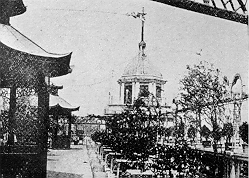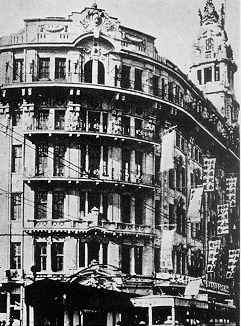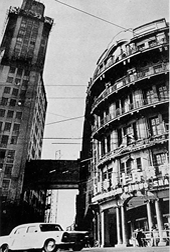 |
 |
 |
|
| |
|
|
 Wing
on Company Recalled Wing
on Company Recalled |
|
 |
Traditionally,
most of the Chinese stores in days of old handled specialized
trades. Though there had been multiple-handling business
establishments dealing in both imported sundry goods and
groceries in cities like Guangzhou in the south and Beijing
in the north, there establishments were of such small
size and had such a small assortment of goods that they
could not be called department stores. Towards the end
of the 19th century, on the Bund close to Nanjing Road
there appeared the Hall & Holtz Co., Ltd., the first
department store in shanghai. In 1913, Whiteaway Laidlaw
& Co., Ltd., which claimed to handle general merchandise
from various parts of the World, was set up at the intersection
of Nanjing and Sichuan Roads. Both department stores,
however, failed to have much influence because they mainly
served foreigners and influential Chinese.
|
In
1917 and 1918 respectively, there emerged Sincere and
Wing on, two large companies dealing in merchandise, thereby
opening up a new field for the trade in question. Thereafter,
department stores of various sizes were opened in Shanghai
and soon other cities in China began to follow suit. Sincere,
Wing On, Sun Sun, and The Sun, the last two having been
established a bit later, were known as the "Four
Big Companies", ranking first in the whole country
for capital, scop, and turnover. Among the four companies
the one having the greatest influence was, as might be
expected, Wing On. The reason, when traced, lay in its
clever moves and shrewd business sense.
|
 The Wing
On Roof Garden, operated by the Wing On Group
The Wing
On Roof Garden, operated by the Wing On Group
|
 The Wing
On Company Building completed in 1918
The Wing
On Company Building completed in 1918
|
In those
days Nanjing road was already the busiest shopping centre
in Shanghai. Prior to Guo's arrangements, the Sincere
Company had elected to open an emporium on the north-south
sector of the intersection of Nanjing Road and Zhejiang
Road where the Guo brothers also planned to erect a building.
With this in mind they surveyed the commercial and residential
situation north and south of Nanjing Road, and found that
while there were few busy sectors north of the road, there
were many residential areas to the south and west with
a good many wealthy families residing there. Then the
two brothers decided to lease the land and have their
own building constructed south of Nanjing Road just opposite
the Sincere Company. Silas Hardoon, the owner of the land,
demanded an annual rent of 50,000 taels of silver for
a lease of 30 years, on the condition that the land was
to be taken back together with the building upon expiration
of the lasse. After meticulous estimations the Guo brother
made up their minds to accept those extremely harsh terms. |
| With
the completion of the building, the Guo brothers, in order
to viewith the Sincere Company and Whiteaway Laidlaw for
business, took great pains with the layout of their four-storied
emporium. On the ground floor were departments selling
daily-use articles, cosmetics, knit goods, hardware, sweets,
biscuits, canned food, cigarettes, ect. Dazzling, attractive
and rich in variety, these items found ready buyers. Departments
on the first floor offered woolen goods, silks and satins,
piece goods and garments for sale. Here the hall was made
much more spacious so that various pieces of materials
could be spread over the counters by the customers. The
second floor was set aside for jewellery, watches and
clocks, and musical instruments, while the third floor
sold furniture, leather suitcases, rugs, and bicycles.
As the two uopper floors handled middle and high-grade
goods, most of the customers going there already had something
in mind to buy, this bringing about a large turnover.
To this day the Wing On-initiated layout is still adopted
by many department stores in other Chinese cities. The
Sincere Company had formerly used the ground floor of
their building as a tea hall, resulting in a crowding
of customers on the first and second floor because of
their relatively small space for business. They then set
about making improvements by imitating Wing On's way of
doing business. |
At
first, Wing On sold mainly imported goods such as French
cosmetics, British woolens, Czechoslovakian glassware,
and Swiss watches. When a widespreas campaign was launched
to advocate buying Chinese goods, Wing On opened up new
sources of homemade goods by setting up their own workshops
and processing factories. Engaging well-known technicians
and skilled workers at high wages, Wing On now shifted
to self-production and self-marketing, and soon made a
name for selling goods of their own make. They also gave
financial aid to a number of small and medium-sized factortes
so that in time they became Wing On's special manufacturers.
As for the local and special products of other parts of
the country such as Jingdezhen porcelain, Fujian lacquerware,
Huzhou silk floss, and Jinhua hams, Wing On sent their
people to the respective producing areas to place orders,
specifying that the goods should be labelled "Made
under the Supervision of the Wing On Company". In
this way, Wing On quite unexpectedly achieved double the
result with half the effort in competition.
|
 The two
buildins of the Wing On Company
The two
buildins of the Wing On Company |
Since
the Wing On Company went into operation on September 5,
1918, its business had blways been good. Thought the company
was renamed the No. 10 Department Store after liberation,
the old name of Wing On has never been forgotten. With
China's adoption of the policy of opening to the outside
world, an agreement has been reached between Shanghai
and the Wing On Group of Hong Kong to the effect that
the No. 10 Department Store will be restored to its original
name. IN addition the building will be extended and there
will be a notable increase of distinctive commodities.
The Wing On Company will soon take on an entirely new
look on Nanjing Road.
|
| |
|
|
|
|
|
|
|
 |
 |
 |
|
|
|
|
|
|
|


